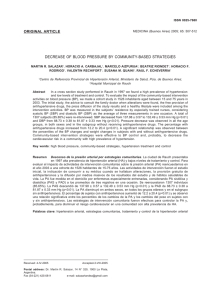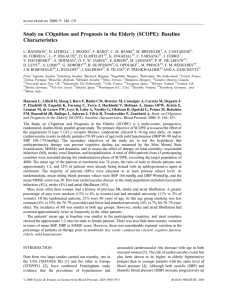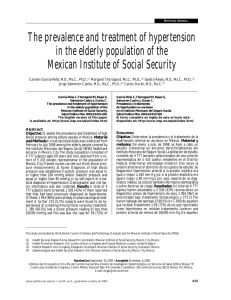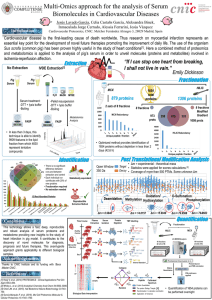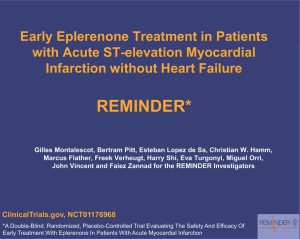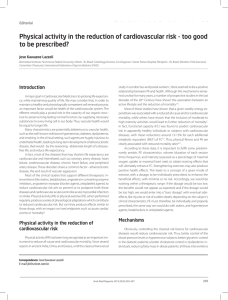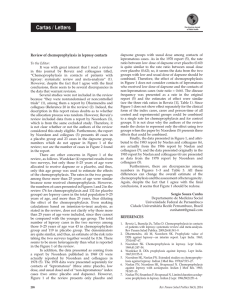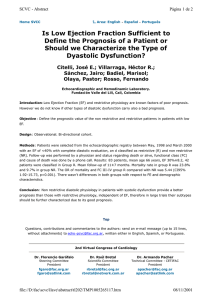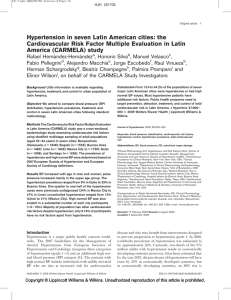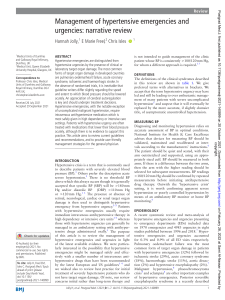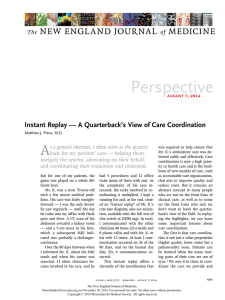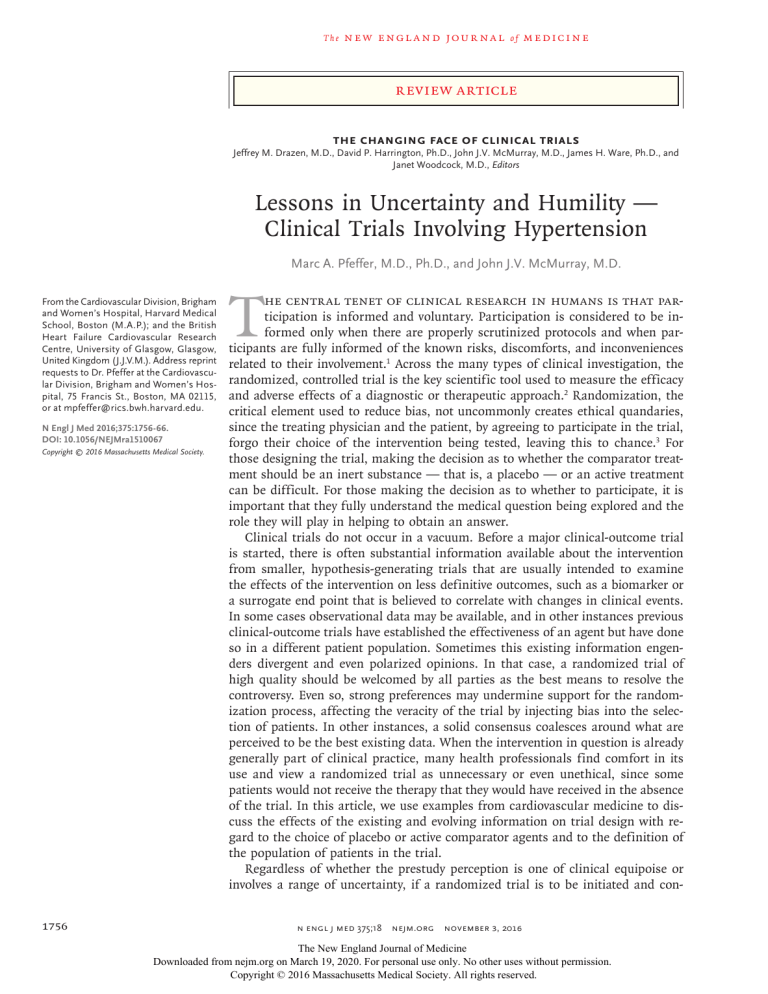
The n e w e ng l a n d j o u r na l of m e dic i n e Review Article The Changing Face of Clinical Trials Jeffrey M. Drazen, M.D., David P. Harrington, Ph.D., John J.V. McMurray, M.D., James H. Ware, Ph.D., and Janet Woodcock, M.D., Editors Lessons in Uncertainty and Humility — Clinical Trials Involving Hypertension Marc A. Pfeffer, M.D., Ph.D., and John J.V. McMurray, M.D. From the Cardiovascular Division, Brigham and Women’s Hospital, Harvard Medical School, Boston (M.A.P.); and the British Heart Failure Cardiovascular Research Centre, University of Glasgow, Glasgow, United Kingdom (J.J.V.M.). Address reprint requests to Dr. Pfeffer at the Cardiovascular Division, Brigham and Women’s Hospital, 75 Francis St., Boston, MA 02115, or at ­mpfeffer@­rics.­bwh.­harvard.­edu. N Engl J Med 2016;375:1756-66. DOI: 10.1056/NEJMra1510067 Copyright © 2016 Massachusetts Medical Society. 1756 T he central tenet of clinical research in humans is that participation is informed and voluntary. Participation is considered to be informed only when there are properly scrutinized protocols and when participants are fully informed of the known risks, discomforts, and inconveniences related to their involvement.1 Across the many types of clinical investigation, the randomized, controlled trial is the key scientific tool used to measure the efficacy and adverse effects of a diagnostic or therapeutic approach.2 Randomization, the critical element used to reduce bias, not uncommonly creates ethical quandaries, since the treating physician and the patient, by agreeing to participate in the trial, forgo their choice of the intervention being tested, leaving this to chance.3 For those designing the trial, making the decision as to whether the comparator treatment should be an inert substance — that is, a placebo — or an active treatment can be difficult. For those making the decision as to whether to participate, it is important that they fully understand the medical question being explored and the role they will play in helping to obtain an answer. Clinical trials do not occur in a vacuum. Before a major clinical-outcome trial is started, there is often substantial information available about the intervention from smaller, hypothesis-generating trials that are usually intended to examine the effects of the intervention on less definitive outcomes, such as a biomarker or a surrogate end point that is believed to correlate with changes in clinical events. In some cases observational data may be available, and in other instances previous clinical-outcome trials have established the effectiveness of an agent but have done so in a different patient population. Sometimes this existing information engenders divergent and even polarized opinions. In that case, a randomized trial of high quality should be welcomed by all parties as the best means to resolve the controversy. Even so, strong preferences may undermine support for the randomization process, affecting the veracity of the trial by injecting bias into the selection of patients. In other instances, a solid consensus coalesces around what are perceived to be the best existing data. When the intervention in question is already generally part of clinical practice, many health professionals find comfort in its use and view a randomized trial as unnecessary or even unethical, since some patients would not receive the therapy that they would have received in the absence of the trial. In this article, we use examples from cardiovascular medicine to discuss the effects of the existing and evolving information on trial design with regard to the choice of placebo or active comparator agents and to the definition of the population of patients in the trial. Regardless of whether the prestudy perception is one of clinical equipoise or involves a range of uncertainty, if a randomized trial is to be initiated and conn engl j med 375;18 nejm.org November 3, 2016 The New England Journal of Medicine Downloaded from nejm.org on March 19, 2020. For personal use only. No other uses without permission. Copyright © 2016 Massachusetts Medical Society. All rights reserved. Clinical Trials Series ducted, the fundamental question it addresses must be worthy of the major collective efforts required of patients, investigators, and sponsors.4 It is important to note that regardless of the level of confidence in the prestudy information, a randomized, controlled trial remains a scientific experiment. Properly worded consent forms should not lead a participant to expect any unproven benefits. Notwithstanding the careful planning of the experts who design the trial, the scrutiny of regulatory agencies, and the commitment of resources from sponsors to demonstrate proposed theoretical benefits, many researchers conclude that the intervention they had hoped would offer a diagnostic or therapeutic advance is no better than the existing options.5,6 The effectiveness of an intervention is best evaluated in randomized trials in which well-defined clinical events are the primary outcome. In the absence of clinical-outcome data that provide definitive direction, surrogate measures are often used to direct therapeutic decisions. Consistent linkage from reliable observational data between a commonly used biologic measurement and prognosis can understandably lead to a perceived association that changes in that biomarker can be reasonably assumed to cause directionally similar alterations in clinical outcomes. For many of these biologic measures, such as levels of high-density lipoprotein cholesterol or hemoglobin, the density of ventricular arrhythmias, and left ventricular ejection fraction, multiple observational studies are available that show such quantitative associations with cardiovascular risk.7 The finding of a quantitative relationship between the degree of deviation of the measured marker from normality and adverse outcomes has on occasion fostered the reasonable expectation for both drug discovery and clinical practice that therapies that restore the abnormal measurement toward normal would have a favorable outcome. In cardiovascular medicine, this comfort zone was shattered by the results of the Cardiac Arrhythmia Suppression Trial, which showed that despite the clear association between the degree of ventricular ectopy and risk of death, anti­ arrhythmic therapy, which was effective in suppressing ventricular premature beats, increased rather than decreased mortality.8 Before this placebo-controlled trial was conducted, a major n engl j med 375;18 emphasis was placed on detecting patients with asymptomatic ventricular arrhythmias in order to initiate antiarrhythmic agents that would provide the assumed benefits. The totally unexpected result — that treating these abnormal rhythms with antiarrhythmic agents was associated with increased mortality — painfully disclosed the false sense of security of what was then a widely adopted clinical practice. The prompt translation of these findings into reductions in the use of these unsafe therapies improved public health and created additional uncertainties. These surprising findings also raised questions about other cardiovascular therapies whose use had became widespread after regulatory evaluations were satisfied, predominantly on the basis of alterations of surrogate measures rather than clinical events. E a r ly Data on Bl o od Pr e ssur e a nd Ou t c ome s Our story is about the treatment of hypertension and the finding in multiple trials that the normalization of blood pressure has been consistently accompanied by beneficial clinical outcomes (Fig. 1). Elevations in systemic arterial pressure were identified in early pioneering epidemiologic studies (e.g., the Framingham Heart Study and the Multiple Risk Factor Intervention Trial [MRFIT]) as being tightly coupled to a heightened risk of illness and death from cardiovascular disease.9,10 A historical review of some of the predominantly government-sponsored randomized trials that were designed to ascertain whether and when long-term antihypertensive therapy lowers these risks illustrates several of the ethical issues that influence the comparators and the patient populations chosen for study as new information is generated. One of the early randomized, placebo-controlled, clinical-outcome trials in cardiovascular medicine, commencing in 1963, was conducted by the Veterans Administration (VA) Cooperative Study Group on Antihypertensive Agents. In its trial involving 143 men whose diastolic blood pressure was between 115 and 129 mm Hg, the group found that the use of a combination of three antihypertensive agents resulted in fewer cardiovascular events than the use of placebo.11 Since the risks and the potential benefits of using pharmacologic agents to reduce blood pres- nejm.org November 3, 2016 The New England Journal of Medicine Downloaded from nejm.org on March 19, 2020. For personal use only. No other uses without permission. Copyright © 2016 Massachusetts Medical Society. All rights reserved. 1757 n e w e ng l a n d j o u r na l The Blood-Pressure Threshold at Which Antihypertensive Medication Should Be Initiated (mm Hg) 160 Systolic blood pressure ≥160 JNC 3 (1984) 150 m e dic i n e JNC 8* (2014) ≥160 ESH–ESC (2003) JNC 4 (1988) ≥150 ≥60 yr No systolic recommendation 140 JNC 6 (1997) ≥140 JNC 5 (1993) 130 JNC 7 (2003) ESH–ESC <60 yr (2013) JNC 8* (2014) ≥140 ESH–ESC (2007) 120 110 ESH–ESC (2003) ≥100 Diastolic blood pressure ≥105 JNC 2 JNC 1 (1980) (1977) 100 90 ≥95 JNC 3 (1984) JNC 4 (1988) ≥90 JNC 5 (1993) 80 0 Trial of 1966 1970 VA 1 VA 2 1975 1980 HDFP Australian Trial 1985 MRC 1990 JNC 6 (1997) 1995 SHEP 2000 Syst-Eur STOP JNC 7 (2003) ALLHAT HOT ALLHAT ≥90 ESH–ESC JNC 8* ESH–ESC (2013) (2014) (2007) 2005 2010 HYVET ACCORD 2015 SPRINT HOPE-3 Figure 1. Trials Influencing Blood-Pressure Thresholds at Which Antihypertensive Medications Should Be Used. ACCORD denotes Action to Control Cardiovascular Risk in Diabetics, ALLHAT Antihypertensive and Lipid-Lowering Treatment to Prevent Heart Attack Trial, Australian Trial the Australian Therapeutic Trial, ESH–ESC the European Society of Hypertension–European Society of Cardiology Guidelines, HDFP Hypertension Detection and Follow-up Program, HOPE Heart Outcomes Prevention Evaluation, HOT Hypertension Optimal Treatment, HYVET Hypertension in the Very Elderly Trial, JNC Joint National Committee on Prevention, Detection, Evaluation, and Treatment of High Blood Pressure, MRC Medical Research Council, SHEP Systolic Hypertension in the Elderly Program, SPRINT Systolic Blood Pressure Intervention Trial, STOP Swedish Trial in Old Patients with Hypertension, Syst-Eur Systolic Hypertension in Europe, and VA Veterans Administration Cooperative Study Group. The asterisk that follows JNC 8 denotes findings that appear as they were submitted by the appointed panel members, without official endorsements. sure were unknown, placebo was unquestionably the correct comparator. The same group concurrently conducted another trial of 380 men whose diastolic pressures were between 90 and 114 mm Hg.12 The lower diastolic pressure of the participants in this trial made placebo the appropriate control for this previously unstudied population. The combination of the participants’ lower diastolic pressure and the fact that this population had not been studied previously also made placebo the appropriate control in this trial. The findings of each of these placebo-controlled trials, which showed that the adverse cardiovascular consequences of elevated blood pressure could be reduced by the administration of antihypertensive medications, are now considered to be foundational evidence for the concept of pre1758 n engl j med 375;18 ventive medicine. However, at the time, the clinical importance of treating an asymptomatic person with the available therapies for lowering blood pressure was not readily accepted by the medical community. R ec o gni t ion of the Da nger s of H y per tension The National High Blood Pressure Education Program was established in 1972 by philanthropist Mary Lasker and then-Secretary of Health, Education, and Welfare Elliot Richardson with the objective of alerting physicians and the public to the risks of hypertension.13 This governmentfunded educational program used phrases such as “the silent killer” to heighten awareness of nejm.org November 3, 2016 The New England Journal of Medicine Downloaded from nejm.org on March 19, 2020. For personal use only. No other uses without permission. Copyright © 2016 Massachusetts Medical Society. All rights reserved. Clinical Trials Series the dangers of elevated blood pressure and to encourage the use of antihypertensive therapy in patients with hypertension. The reluctance of the medical community to accept the findings of the two VA trials was reflected in the design of subsequent major trials focused on hypertension. The investigators conducting the Hypertension Detection and Follow-up Program (HDFP) that was sponsored by National Institutes of Health designed their trial to determine whether improved blood-pressure control could prolong survival. The trial included nearly 11,000 people, and enrollment began in 1974. Given that study entry required a diastolic blood pressure of at least 90 mm Hg (with more than 1000 participants having a diastolic pressure of more than 115 mm Hg at study entry), the HDFP was in some respects an effort to confirm the results of the VA trials while also expanding the population covered to include women and younger people. Despite these population differences, the designers of the HDFP “agreed that the results of the Veterans trials made it inappropriate to use placebo controls.”14 This clear statement and early shift from placebo to an active comparator indicated that the investigators believed that it was unethical to withhold the opportunity for antihypertensive therapy from participants during a long-term clinical trial. However, the tension between clinical investigators and community practitioners with regard to the acceptance of the existing data was reflected in the trial design and the differential use of antihypertensive drugs between groups. In this 5-year HDFP, a total of 10,940 volunteers (46% of whom were women) were randomly assigned to receive either stepped care (SC), in which antihypertensive therapy was provided at specialized sites and doses increased to achieve and maintain specific blood-pressure goals, or referred care (RC), in which participants were referred to their usual sources of care. The design was based on an inherent assumption that despite the absence of placebo, the ambivalence of the medical community toward antihypertensive drugs would result in fewer prescriptions in the RC group than in the SC group. Although a considerable number of patients in each group remained untreated, the percentage was more than twice as high in the RC group at year 2, with 18.5% of the SC group and 41.7% of the RC group remaining untreated. The goal of attainn engl j med 375;18 ing a diastolic pressure of less than 90 mm Hg was achieved in 56.7% of the patients in the SC group and in only 33.7% of the patients in the RC group. Even this difference in the intensity of blood-pressure treatment was associated with a statistically and clinically significant difference in mortality, which was 17% lower in the SC group than in the RC group.14 The response of the international medical community to the results of the two relatively small initial VA studies was even more restrained than that in the United States. Near the time at which the HDFP was being conducted in the United States, three trials related to hypertension control were being performed outside the United States. In each of these trials, placebo was select­ ed as the comparator (Table 1). Entry into the European Working Party Trial16 and the Medical Research Council Trial (conducted in the Unit­ ed Kingdom)17 required a diastolic pressure of 90 mm Hg or higher, and entry into the Australian Therapeutic Trial15 required a diastolic pressure of 95 mm Hg or higher. The use of placebo in all three trials, which commenced in the 1970s, was a clear indication that the researchers’ level of uncertainty with regard to the need to treat people with this level of blood pressure was higher than it was for the U.S. investigators in the HDFP. Nonetheless, hypertension knows no borders, and all three trials showed that fewer cardiovascular events occurred among patients with better blood-pressure control. With these findings, the importance of lowering blood pressure was solidified (Table 1). The design of the Hypertension Optimal Treatment (HOT) trial, conducted in the mid-1990s, showed that the international community of researchers who were investigating hypertension had accepted the proposition that in patients with elevated diastolic blood pressure, the reduction of that pressure with antihypertensive drugs improved cardiovascular outcomes.21 In the HOT trial, the diastolic pressure of participants was between 100 and 115 mm Hg, and all received active antihypertensive therapy. Participants were randomly assigned to one of three groups in which the targeted diastolic blood pressures were less than 90, less than or equal to 85, or less than or equal to 80 mm Hg. Although no significant differences in the rates of major cardiovascular events were observed across the three levels of treatment intensity, this trial, which included nejm.org November 3, 2016 The New England Journal of Medicine Downloaded from nejm.org on March 19, 2020. For personal use only. No other uses without permission. Copyright © 2016 Massachusetts Medical Society. All rights reserved. 1759 1760 Treatment: 183/101 Placebo: 182/101 Men Thiazide: 158/98 Propanolol: 158/98 Placebo: 158/98 Women Thiazide: 165/98 Propanolol: 165/98 Placebo: 165/98 Treatment: 171/77 Placebo: 170/76 Treatment: 195/102 Placebo: 195/102 Stepped care vs. referred care Antihypertensive treatment vs. placebo Diastolic pressure 95– 109 mm Hg, systolic pressure <200 mm Hg Diastolic pressure Antihypertensive treat90–119 mm Hg, systolic ment vs. placebo pressure 160–239 mm Hg Diastolic pressure Thiazide or propanolol 90–109 mm Hg, systolic vs. placebo pressure <200 mm Hg Antihypertensive treatment vs. placebo Diastolic pressure 90 to >115 mm Hg Systolic pressure >160 mm Hg, diastolic pressure <90 mm Hg; age ≥60 yr Diastolic pressure 105–120 Antihypertensive treatmm Hg or diastolic ment vs. placebo pressure ≥90 mm Hg with systolic pressure 180–230 mm Hg; age 70–84 yr HDFP (1979)14 Duration: 1974–1979 Participants: 10,940 Australian Therapeutic Trial (1980)15 Duration: 1973–1979 Participants: 3427 European Working Party Trial (1985)16 Duration: 1972–1984 Participants: 840 MRC (1985)17 Duration: 1977–1985 Participants: 17,354 SHEP (1991)18 Duration: 1985–1991 Participants: 4736 STOP (1991)19 Duration: 1985–1991 Participants: 1627 Treatment: 158/101 Placebo: 157/100 Stepped care: 159/101 Referred care: 159/101 Treatment: 162/104 Placebo: 165/105 Antihypertensive treatment vs. placebo Men with diastolic pressure 90–114 mm Hg Treatment: 186/121 Placebo: 187/121 mm Hg Blood Pressure at Inclusion VA Group 2 (1970)12 Duration: 1963–1969 Participants: 380 Comparators Antihypertensive treatment vs. placebo 11 Eligibility VA Group 1 (1967) Men with diastolic pressure Duration: 1963–1967 115–129 mm Hg Participants: 143 Trial Table 1. Major Outcome of Trials Assessing the Risks and Benefits of Treating Elevated Blood Pressure.* n engl j med 375;18 nejm.org Blood pressures required for eligibility overlapped with those of some previous trials; openlabel antihypertensive treatment for those with blood pressure >230/120 mm Hg Active therapy recommended for patients with systolic pressure >240 mm Hg or diastolic pressure >115 mm Hg at single visit and patients with sustained systolic pressure >220 mm Hg or sustained diastolic pressure >90 mm Hg Previous data considered insufficient for general recommendations; active drug initially recommended for patients with systolic pressure ≥210 mm Hg or diastolic pressure ≥115 mm Hg; reduced during trial to ≥200 mm Hg and ≥110 mm Hg, respectively Previous data considered insuf­ ficient for general recommendations Previous data considered insuf­ ficient for general recommendations All patients could be treated Diastolic pressure different at entry; unstudied population Unstudied population Issues Regarding Use of Placebo of Yes Yes Yes Yes Yes No Yes Yes Placebo Used n e w e ng l a n d j o u r na l Decrease of 38% in cardiovascular death, myocardial infarction, or stroke (P = 0.003) Decrease of 36% in fatal and nonfatal stroke (P<0.001) Decrease of 46% in stroke (P<0.01) and 19% in ­cardiovascular events (P<0.05) Decrease of 27% in cardiovascular death (P = 0.04) Decrease of 20% in composite of morbid cardiovascular events and deaths (P<0.05) Decrease of 17% in all-cause mortality (P<0.01) Decrease of 70% in composite of cardiovascular events and deaths Decrease in composite of cardiovascular events and deaths Outcome The m e dic i n e November 3, 2016 The New England Journal of Medicine Downloaded from nejm.org on March 19, 2020. For personal use only. No other uses without permission. Copyright © 2016 Massachusetts Medical Society. All rights reserved. n engl j med 375;18 nejm.org November 3, 2016 The New England Journal of Medicine Downloaded from nejm.org on March 19, 2020. For personal use only. No other uses without permission. Copyright © 2016 Massachusetts Medical Society. All rights reserved. Type 2 diabetes, risk factors Intensive control (target ACCORD (2010)25 Duration: 2001–2009 for cardiovascular dis<120 mm Hg) or Participants: 4733 ease (can be taking standard control ­antihypertensive ­(target <140 mm Hg) ­medication) Antihypertensive treatment vs. placebo Systolic pressure ≥160 mm Hg; age ≥80 yr HYVET (2008)24 Duration: 2000–2007 Participants: 3845 No significant difference in rate of stroke (P<0.06), but 21% decrease in mortality with treatment (P<0.02) As compared with chlorthalidone, no significant difference with lisinopril or amlodipine for primary outcome of death from coronary heart disease or nonfatal myocardial infarction No significant difference in primary outcome of death from coronary heart disease or nonfatal myocardial infarction; trial terminated prematurely when rate of heart failure with doxazosin ­increased 104% vs. chlorthalidone (P<0.001) No significant difference in rate of cardiovascular death, myocardial infarction, or stroke across all three groups; however, fewer clinical events in patients with diabetes in subgroup targeting lower diastolic pressure Decrease of 42% in stroke (P = 0.003) Outcome Intensive control: 139/76 No significant difference Standard control: 139/76 in primary outcomes of death from cardiovascular disease or nonfatal myocardial infarction or stroke (P = 0.20) Treatment: 173/91 Placebo: 173/91 Chlorthalidone vs. lisino- Chlorthalidone: 146/84 pril vs. amlodipine Lisinopril: 146/84 Amlodipine: 146/84 Diastolic pressure ≥90 mm Hg or systolic pressure ≥140 mm Hg and one or more risk factors for coronary heart disease; age ≥55 yr ALLHAT (2002)23 Duration: 1994–2002 Participants: 33,357 Chlorthalidone: 145/83 Doxazosin: 145/84 Participants in each of three treatment groups: 170/105 Systolic pressure Chlorthalidone vs. doxa≥140 mm Hg or zosin ­diastolic pressure ≥90 mm Hg and one or more risk factors for coronary heart disease; age ≥55 yr Different intensities of antihypertensive ­treatment intended to target diastolic blood pressures of <90, ≤85, or ≤80 mm Hg Diastolic pressure 100–115 mm Hg HOT trial (1998)21 Duration: 1992–1997 Participants: 18,790 Treatment: 174/86 Placebo: 174/86 mm Hg Blood Pressure at Inclusion ALLHAT (2000)22 Duration: 1994–1999 Participants: 24,335 Antihypertensive treatment vs. placebo Comparators Diastolic pressure <95 mm Hg with ­systolic pressure 160–219 mm Hg; age ≥60 yr Eligibility Syst-Eur (1997)20 Duration: 1989–1997 Participants: 4695 Trial No Yes No No No Yes Placebo Used Addressed effects of treatment intensity rather than treatment initiation Intended to address problem of limited data or risks and benefits of treatment availability among octogenarians; active treatment provided for patients with systolic blood pressure ≥220 mm Hg or diastolic pressure ≥110 mm Hg Intended to control blood pressure and address potential differences between agents Intended to control blood pressure and address potential differences between agents Therapy started with calciumchannel blocker, with ACE ­inhibitor, beta-blocker, diuretic, or any combination thereof added; three levels of reduction of diastolic ­pressure targeted Eligibility requirements similar to SHEP and STOP; active treatment for systolic pressure >219 mm Hg or diastolic pressure >99 mm Hg; during trial, ethics committee lowered eligible systolic pressure to 200 mm Hg Issues Regarding Use of Placebo Clinical Trials Series 1761 1762 No significant difference in rates of cardiovascular death, nonfatal myocardial infarction, or stroke No known cardiovascular Candesartan plus hydroHOPE–3 (2016)27 Duration: 2007–2015 disease, but at least one chlorothiazide vs. Participants: 12,705 risk factor for cardiovas­placebo, with 2-by-2 cular disease; need for factorial design of initiation of hypertensive statin vs. placebo treatment determined on basis of local standards Treatment: 138/82 Placebo: 138/82 Decrease of 25% for primary outcome of death from cardiovascular disease, acute coronary syndrome, myocardial infarction, or stroke, or heart failure (P<0.001); decrease of 27% in ­mortality (P = 0.003) *ACCORD denotes Action to Control Cardiovascular Risk in Diabetics, ACE angiotensin-converting–enzyme, ALLHAT Antihypertensive and Lipid-Lowering Treatment to Prevent Heart Attack Trial, HDFP Hypertension Detection and Follow-up Program, HOPE Heart Outcomes Prevention Evaluation, HOT Hypertension Optimal Treatment, HYVET Hypertension in the Very Elderly Trial, MRC Medical Research Council, SHEP Systolic Hypertension in the Elderly Program, SPRINT Systolic Blood Pressure Intervention Trial, STOP Swedish Trial in Old Patients with Hypertension, Syst-Eur Systolic Hypertension in Europe, and VA Group Veterans Administration Cooperative Study Group. Yes Addressed lower end of bloodpressure spectrum and risk spectrum n e w e ng l a n d j o u r na l Systolic pressure Intensive control (target Intensive control: 140/78 SPRINT (2015) Duration: 2010–2015 130–180 mm Hg, <120 mm Hg) or Standard control: 140/78 Participants: 9361 risk factors for cardiostandard control (tarvascular disease (perget <140 mm Hg) sons participating in ACCORD or history of stroke excluded; can be taking antihypertensive medication) mm Hg 26 Trial Table 1. (Continued.) Eligibility Comparators Blood Pressure at Inclusion Outcome No Placebo Used Issues Regarding Use of Placebo Like ACCORD, trial addressed ­effects of treatment intensity rather than treatment initiation but in different patient population The n engl j med 375;18 of m e dic i n e 18,790 participants, made a clear statement that elevated diastolic pressure should be lowered to at least 90 mm Hg. Shif t t o S ys t ol ic Pr e ssur e The Systolic Hypertension in the Elderly Program (SHEP), which was conducted from 1985 through 1991, involved 4736 patients, was one of the first trials to address the use of systolic blood pressure as a guide for initiating anti­ hypertensive treatment. In order to participate, a patient had to have a systolic blood pressure between 160 and 219 mm Hg and a diastolic pressure of less than 90 mm Hg (average blood pressure, 170/77 mm Hg).18 Although these levels of systolic pressure are very high by today’s standards, the benefits and risks of antihypertensive therapy in this generally older population were unknown at the time the trial was conducted. Although placebo was used as the control, the trial included an “escape” clause that allowed for the initiation of open-label therapy for patients whose systolic blood pressure was higher than 220 mm Hg. At year 2, a total of 6.7% of the active-treatment group and 70.9% of the placebo group were not being treated, and the betweengroup difference in systolic pressure was approximately 13 mm Hg. The active-treatment group had a rate of stroke that was 36% lower than that in the placebo group and a composite rate of nonfatal myocardial infarction, death from coronary heart disease, or heart failure that was 33% lower. The European Working Party on High Blood Pressure in the Elderly investigated isolated systolic hypertension in the Systolic Hypertension in Europe (Syst-Eur) trial.20 The entry criterion for this randomized, placebo-controlled trial was a systolic blood pressure of 160 to 219 mm Hg, with a diastolic pressure of less than 95 mm Hg. The Syst-Eur trial, which was conducted from 1989 through 1997, was continued after the results of SHEP were known “because of remaining uncertainties about the treatment of isolated systolic hypertension in the elderly.”20 The trial was stopped after an interim analysis showed that the incidence of the primary end point (stroke) was 42% lower in the active-treatment group than in the placebo group (P = 0.003). The incidence of heart failure and myocardial infarction was 25% lower in the active-treatment group. nejm.org November 3, 2016 The New England Journal of Medicine Downloaded from nejm.org on March 19, 2020. For personal use only. No other uses without permission. Copyright © 2016 Massachusetts Medical Society. All rights reserved. Clinical Trials Series The Swedish Trial in Old Patients with Hypertension (STOP-Hypertension) was also conducted during this period (1985–1991) and also used placebo rather than active treatment in the comparator group.19 On entry into the trial, participants had to have a diastolic blood pressure between 105 and 120 mm Hg (irrespective of systolic pressure) or both a diastolic pressure of at least 90 mm Hg and a systolic pressure between 180 and 230 mm Hg. The diastolic criteria overlapped with those for participation in previous trials, as the investigators acknowledged in their stated objective: “to confirm the value of antihypertensive treatment in people age 70–74 years and to expand the database up to the age of 84 years.” The blood-pressure levels at year 2 of the study were 188/97 mm Hg in the placebo group and 166/87 mm Hg in the treatment group. The rate of cardiovascular death, myocardial infarction, or stroke was 38% lower in the activetreatment group (Table 1). These trials from the 1980s and early 1990s generated the data needed to develop a systolic blood-pressure target for the initiation of antihypertensive therapy. The cumulative evidence provided the basis for the recommendations initially made in the 1993 report of the Joint National Committee on Prevention, Detection, Evaluation, and Treatment of High Blood Pressure (Fig. 1) to start long-term antihypertensive therapy at a systolic pressure of 140 mm Hg or higher or a diastolic pressure of 90 mm Hg or higher. Emergence of E thic a l Issue s a s K now l ed ge Ac cumul ate s The ethical boundaries of finding sufficient uncertainty for the use of placebo in patients with hypertension were probed more recently in the Hypertension in the Very Elderly Trial (HYVET), which was conducted from 2000 through 2007. In this major outcome trial, active antihypertensive therapy was compared with placebo in patients 80 years of age or older who had a systolic pressure of 160 mm Hg or higher.24 The rationale was that minimal data on the effectiveness or safety of antihypertensive therapy were available in this population. Although the rate of the primary end point of stroke was not significantly lower than the rate with placebo, the 21% lower rate of death (P<0.02) in the active antihypertenn engl j med 375;18 sive-therapy group confirmed the importance of lowering blood pressure regardless of age and closed the chapter on the use of placebo in controlled trials addressing this level of hypertension (Table 1). In the Heart Outcomes Prevention Evaluation (HOPE)–3 trial,27 the results of which were reported in spring 2016, the investigators used placebo as the comparator with active combination antihypertensive therapy to evaluate the risks and benefits of blood-pressure control in persons whom investigators believed did not have a clear current indication for the active therapies being evaluated. Participants could enter the trial after blood-pressure control was attained with lifestyle interventions or with drugs other than an angiotensin-receptor–blocker, an angiotensin-converting-enzyme inhibitor, or a thiazide diuretic. In effect, this design, which permitted some participants in the control group to receive antihypertensive therapy, was a hybrid between no treatment and add-on therapy, since at baseline 22% of patients were already receiving treatment intended to lower blood pressure. With the mean blood pressure at baseline at 138/82 mm Hg, some participants had a bloodpressure level that was above the existing treatment targets and the targets being introduced at the time the trial started (Fig. 1). The trial results were neutral, with no significant difference reported between placebo and active therapy for the composite rate of cardiovascular events. However, in a subgroup analysis of the participants with the highest systolic pressure at trial entry (>143.5 mm Hg), those who received combination antihypertensive therapy had fewer cardiovascular events than those receiving placebo. What made this modern placebo-controlled trial distinctive was the fact that it explored the lower limits at which antihypertensive therapy should be provided by offering treatment to participants who were not considered to need either initiation of such treatment or any additional treatment — an understudied population with an annual risk of major cardiovascular events of approximately 1%. The trial also had a 2-by-2 factorial design in which a statin was provided for the purpose of preventing cardiovascular events without the use of lipid or blood-pressure targets or monitoring. As the data on the benefits of antihypertensive therapy have increased, ethical standards in nejm.org November 3, 2016 The New England Journal of Medicine Downloaded from nejm.org on March 19, 2020. For personal use only. No other uses without permission. Copyright © 2016 Massachusetts Medical Society. All rights reserved. 1763 The n e w e ng l a n d j o u r na l this field have continued to evolve.28 Generally, institutional review boards will permit only shortterm withholding (approximately 2 to 4 weeks) of antihypertensive medications (within a nonsevere blood-pressure range) to establish baseline blood pressure. Most current trials assessing the effects of lowering blood pressure compare the effects of a new therapy with those of an established comparator rather than placebo.23,28-31 The comparisons between specific antihypertensive agents are often made at doses that achieve similar degrees of blood-pressure control. Although some large clinical-outcome trials that compare specific antihypertensive agents have been conducted to identify possible benefits of treatment other than that of lowering blood pressure,23,29,31 for the most part reductions in the occurrence of major cardiovascular events are more closely related to the extent to which blood pressure is lowered than to the class of agent used.32 One of the largest trials in which active agents were used as comparators was the Antihypertensive and Lipid-Lowering Treatment to Prevent Heart Attack Trial (ALLHAT) sponsored by the National Heart, Lung, and Blood Institute (NHLBI), in which a diuretic was compared with three other classes of antihypertensive drug.23 In this trial, which was conducted from 1994 through 2002, the finding that the risk of the development of heart failure was twice as high with doxazosin as it was with chlorthalidone provided the research community with an important lesson in humility.22 Be yond Pl acebo The clinical-outcome trials involving hypertension that were conducted in the past decade addressed the level at which antihypertensive treatment should be initiated and at what intensity; these trials did not use a placebo. Since the epidemiologic data relating blood pressure and cardiovascular risk do not show a clear threshold (i.e., a level below which risk does not appear to diminish),9,10 there was a widely held belief that the use of antihypertensive drugs to bring blood pressure below the operational definition of hypertension would further improve prognosis. For patients with type 2 diabetes, this belief was supported by a subgroup analysis from the HOT trial that showed that among the 1501 patients 1764 n engl j med 375;18 of m e dic i n e in the trial who had diabetes, there was a gradation in the observed rate of cardiovascular events across the three groups that had met the target diastolic pressure.21 This finding led to the recommendation of an even lower target blood pressure in these patients.28 However, it was acknowledged that this target was based on subgroup data. There was sufficient uncertainty regarding the recommendation that one aspect of the NHLBIsponsored Action to Control Cardiovascular Risk in Diabetics (ACCORD) trial was specifically designed to address this question.25 In ACCORD, an open-label trial that commenced in 2001, patients were randomly assigned to receive either intensive antihypertensive therapy targeting systolic blood pressures of less than 120 mm Hg or standard therapy targeting systolic blood pressures of less than 140 mm Hg. The group receiving standard treatment was to have at least the currently recommended level of blood-pressure control, and the focus was on between-group differences in blood-pressure levels, not on the specific antihypertensive agents used. The group receiving intensive treatment was in effect providing the unknown relative efficacy and safety data related to the use of a greater number of antihypertensive medications intended to lower blood pressure to levels not previously studied in major clinical-outcome trials. Despite achieving an impressive average difference of 14 mm Hg in systolic pressure, the primary composite outcome of time to cardiovascular death, myocardial infarction, or stroke was not lower in the group receiving intensive therapy than in the group receiving standard therapy. The trial also showed that there was a downside to the strategy of striving for greater and greater reductions in blood pressure, since a higher number of serious adverse events (i.e., events that were life-threatening, caused permanent disability, or necessitated hospitalization) that were attributed to antihypertensive medications were reported in the group receiving intensive treatment. The results of the ACCORD trial did not align with expert consensus,34 which provided another lesson in humility from a wellconducted outcome trial that improved practice and defied expert opinion. The even more recent NHLBI-sponsored Systolic Blood Pressure Intervention Trial (SPRINT),26 nejm.org November 3, 2016 The New England Journal of Medicine Downloaded from nejm.org on March 19, 2020. For personal use only. No other uses without permission. Copyright © 2016 Massachusetts Medical Society. All rights reserved. Clinical Trials Series the results of which were published in 2015, addressed the same question in a population with a high level of cardiovascular risk. However, in light of the neutral findings related to target blood pressures from the ACCORD trial and the Secondary Prevention of Small Subcortical Strokes trial,33 the SPRINT investigators excluded patients with diabetes or a history of stroke. Again, the design was a randomized, controlled trial in which patients used open-label antihypertensive agents to a target systolic pressure of either less than 120 or less than 140 mm Hg. Although in the ACCORD trial the group receiving the more intensive approach to lowering systolic blood pressure did not have a benefit–risk profile that justified this approach in persons with diabetes, the SPRINT investigators felt justified in testing the same hypothesis in patients with elevated blood pressure who were not known to have diabetes. On the heels of the ACCORD trial, the early termination of the SPRINT trial for reasons of efficacy came as a surprise. The data showed that more intensive lowering of blood pressure, below the currently recommended level, significantly reduced rates of cardiovascular end points and the risk of death.26 Once scrutinized, it seems likely that this new information will once again change current authoritative recommendations for standard practice in an effort to improve public health (Fig. 1).34 References 1. Grady C. Enduring and emerging challenges of informed consent. N Engl J Med 2015;372:855-62. 2. Califf RM, DeMets DL. Principles from clinical trials relevant to clinical practice. Circulation 2002;106:1015-21. 3. Chalmers TC, Celano P, Sacks HS, Smith H Jr. Bias in treatment assignment in controlled clinical trials. N Engl J Med 1983;309:1358-61. 4. Eisenstein EL, Lemons PW II, Tardiff BE, Schulman KA, Jolly MK, Califf RM. Reducing the costs of phase III cardiovascular clinical trials. Am Heart J 2005;149: 482-8. 5. Ridker PM, Torres J. Reported outcomes in major cardiovascular clinical trials funded by for-profit and not-forprofit organizations: 2000-2005. JAMA 2006;295:2270-4. 6. Gordon D, Taddei-Peters W, Mascette A, Antman M, Kaufmann PG, Lauer MS. Publication of trials funded by the National Heart, Lung, and Blood Institute. N Engl J Med 2013;369:1926-34. L e ssons L e a r ned The privilege of conducting human research requires investigators to minimize the risks to participants and to inform participants of these risks by providing them with the most accurate current information available. Randomized trials should be conducted within an ethical framework that allows all participants access to the best possible care (as determined regionally) and to an experimental comparator about which the preliminary information is sufficient to suggest a degree of efficacy that justifies the conduct of a clinical trial (given the inherent uncertainty involved). As new information is generated and the degree of uncertainty diminished, these developments should be reflected in the selection of proper comparators. The history of randomized, controlled trials involving hypertension shows that the level of uncertainty or, conversely, the interpretation of the robustness of the currently available data can vary among physicians within a country and across geographic regions. A review of this history underscores the sanctity of the central tenet of the consent process: properly informing the voluntary participants of relevant information at the time of enrollment so that they can make a truly informed decision. Disclosure forms provided by the authors are available with the full text of this article at NEJM.org. Fleming TR, DeMets DL. Surrogate end points in clinical trials: are we being misled? Ann Intern Med 1996;125:605-13. 8. Echt DS, Liebson PR, Mitchell LB, et al. Mortality and morbidity in patients receiving encainide, flecainide, or placebo: the Cardiac Arrhythmia Suppression Trial. N Engl J Med 1991;324:781-8. 9. Kannel WB, Dawber TR, Kagan A, Revotskie N, Stokes J III. Factors of risk in the development of coronary heart disease — six year follow-up experience: the Framingham Study. Ann Intern Med 1961; 55:33-50. 10. Multiple Risk Factor Intervention Trial Research Group. Multiple Risk Factor Intervention Trial: risk factor changes and mortality results. JAMA 1982;248:1465-77. 11. Veterans Administration Cooperative Study Group on Antihypertensive Agents. Effects of treatment on morbidity in hypertension: results in patients with diastolic blood pressures averaging 115 through 129 mm Hg. JAMA 1967;202:1028-34. 12. Veterans Administration Cooperative 7. n engl j med 375;18 nejm.org Study Group on Antihypertensive Agents. Effects of treatment on morbidity in hypertension. II. Results in patients with diastolic blood pressure averaging 90 through 114 mm Hg. JAMA 1970;213:1143-52. 13. Jones DW, Hall JE. The National High Blood Pressure Education Program: thirty years and counting. Hypertension 2002; 39:941-2. 14. Hypertension Detection and Followup Program Cooperative Group. Five-year findings of the hypertension detection and follow-up program. I. Reduction in mortality of persons with high blood pressure, including mild hypertension. JAMA 1979;242:2562-71. 15. The Australian Therapeutic Trial in mild hypertension: report by the Management Committee. Lancet 1980;1:1261-7. 16. Amery A, Birkenhäger W, Brixko P, et al. Mortality and morbidity results from the European Working Party on High Blood Pressure in the Elderly trial. Lancet 1985;1:1349-54. 17. Medical Research Council Working November 3, 2016 The New England Journal of Medicine Downloaded from nejm.org on March 19, 2020. For personal use only. No other uses without permission. Copyright © 2016 Massachusetts Medical Society. All rights reserved. 1765 Clinical Trials Series Party. MRC trial of treatment of mild hypertension: principal results. Br Med J (Clin Res Ed) 1985;291:97-104. 18. SHEP Cooperative Research Group. Prevention of stroke by antihypertensive drug treatment in older persons with isolated systolic hypertension: final results of the Systolic Hypertension in the Elderly Program (SHEP). JAMA 1991;265:3255-64. 19. Dahlöf B, Lindholm LH, Hansson L, Scherstén B, Ekbom T, Wester PO. Morbidity and mortality in the Swedish Trial in Old Patients with Hypertension (STOPHypertension). Lancet 1991;338:1281-5. 20. Staessen JA, Fagard R, Thijs L, et al. Randomised double-blind comparison of placebo and active treatment for older patients with isolated systolic hypertension. Lancet 1997;350:757-64. 21. Hansson L, Zanchetti A, Carruthers SG, et al. Effects of intensive blood-pressure lowering and low-dose aspirin in patients with hypertension: principal results of the Hypertension Optimal Treatment (HOT) randomised trial. Lancet 1998;351: 1755-62. 22. The ALLHAT Collaborative Research Group. Major cardiovascular events in hypertensive patients randomized to doxazosin vs chlorthalidone: the antihypertensive and lipid-lowering treatment to prevent heart attack trial (ALLHAT). JAMA 2000;283:1967-75. 23. The ALLHAT Officers and Coordina- tors for the ALLHAT Collaborative Research Group. Major outcomes in highrisk hypertensive patients randomized to angiotensin-converting enzyme inhibitor or calcium channel blocker vs diuretic: the Antihypertensive and Lipid-Lowering Treatment to Prevent Heart Attack Trial (ALLHAT). JAMA 2002;288:2981-97. 24. Beckett NS, Peters R, Fletcher AE, et al. Treatment of hypertension in patients 80 years of age or older. N Engl J Med 2008; 358:1887-98. 25. The ACCORD Study Group. Effects of intensive blood-pressure control in type 2 diabetes mellitus. N Engl J Med 2010;362: 1575-85. 26. The SPRINT Research Group. A randomized trial of intensive versus standard blood-pressure control. N Engl J Med 2015; 373:2103-16. 27. Lonn EM, Bosch J, López-Jaramillo P, et al. Blood-pressure lowering in intermediate-risk persons without cardiovascular disease. N Engl J Med 2016;374:2009-20. 28. Chobanian AV, Bakris GL, Black HR, et al. The Seventh Report of the Joint National Committee on Prevention, Detection, Evaluation, and Treatment of High Blood Pressure: the JNC 7 report. JAMA 2003;289:2560-72. 29. Dahlöf B, Devereux RB, Kjeldsen SE, et al. Cardiovascular morbidity and mor- tality in the Losartan Intervention For Endpoint reduction in hypertension study (LIFE): a randomised trial against atenolol. Lancet 2002;359:995-1003. 30. Julius S, Kjeldsen SE, Weber M, et al. Outcomes in hypertensive patients at high cardiovascular risk treated with regimens based on valsartan or amlodipine: the VALUE randomised trial. Lancet 2004; 363:2022-31. 31. Jamerson K, Weber MA, Bakris GL, et al. Benazepril plus amlodipine or hydrochlorothiazide for hypertension in highrisk patients. N Engl J Med 2008;359:241728. 32. Blood Pressure Lowering Treatment Trialists’ Collaboration. Effects of different blood-pressure-lowering regimens on major cardiovascular events: results of prospectively-designed overviews of randomised trials. Lancet 2003;362:1527-35. 33. The SPS3 Study Group. Blood-pressure targets in patients with recent lacunar stroke: the SPS3 randomised trial. Lancet 2013;382:507-15. 34. James PA, Oparil S, Carter BL, et al. 2014 Evidence-based guideline for the management of high blood pressure in adults: report from the panel members appointed to the Eighth Joint National Committee (JNC 8). JAMA 2014;311:50720. Copyright © 2016 Massachusetts Medical Society. specialties and topics at nejm.org Specialty pages at the Journal’s website (NEJM.org) feature articles in cardiology, endocrinology, genetics, infectious disease, nephrology, pediatrics, and many other medical specialties. These pages, along with collections of articles on clinical and nonclinical topics, offer links to interactive and multimedia content and feature recently published articles as well as material from the NEJM archive (1812–1989). 1766 n engl j med 375;18 nejm.org November 3, 2016 The New England Journal of Medicine Downloaded from nejm.org on March 19, 2020. For personal use only. No other uses without permission. Copyright © 2016 Massachusetts Medical Society. All rights reserved.
